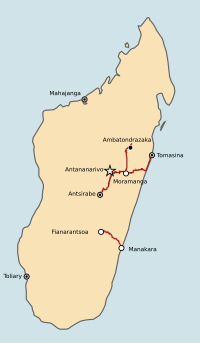Transport in Madagascar
Paved and unpaved roadways, as well as railways, provide the main forms of transport in Madagascar. Madagascar has approximately 31,640 km (19,660 mi)[1] of paved roads and 836 km of rail lines.[2] In 2010, Madagascar had 432 km (270 mi) of navigable waterways.[3]
Railways[]

In 2018, Madagascar reported 836 km of rail lines.[1] There are several rail lines and stations in Madagascar. Antananarivo is connected to Toamasina, Ambatondrazaka and Antsirabe by rail, and another rail line connects Fianarantsoa to Manakara. The northern railway (TCE) is concessioned to Madarail. The southern line, Fianarantsoa-Côte-Est railway (FCE), is a parastatal line.[citation needed]
Roads[]
Madagascar reported 31,640 km of roadways, of which only 10 percent were in good condition. 64 percent are considered to be in poor condition.[1]
The majority of roads in Madagascar are unpaved, with many becoming impassable in the rainy season. Largely paved national routes connect the six largest regional towns to Antananarivo, with minor paved and unpaved routes providing access to other population centers in each district.[4]
Waterways[]

The relatively short rivers of Madagascar are typically of local importance only; isolated streams and small portions of Lakandranon' Ampangalana (Canal des Pangalanes) are navigated by pirogue. Coastal inter-city transport routes are found along the west coast.[citation needed]
Madagascar has 600 km of waterways, 432 km of which are navigable.[1]
Ports and harbors[]
The most important seaport in Madagascar is located on the east coast at Toamasina. Ports at Toliara, Mahajanga, and Antsiranana are significantly less used because of their remoteness.[4] The island's newest port at Port d'Ehola, constructed in 2008 and privately managed by Rio Tinto, will come under state control upon completion of the company's mining project near Tôlanaro around 2038.[5] The country's principal cargo port is Toamasina Autonomous Port.[6]
Airports[]

The main international airport in Madagascar is Ivato International Airport in Antananarivo. Air Madagascar services the island's many small regional airports, which offer the only practical means of access to many of the more remote regions during rainy season road washouts.[4] There are 26 airports with paved runways and 57 airports with unpaved runways.[7] In 2018, Madagascar carried 544,458 air passengers.[8]
See also[]
- List of airports by ICAO code
Notes[]
- ^ a b c d "2.3 Madagascar Road Network - Logistics Capacity Assessment - Digital Logistics Capacity Assessments". dlca.logcluster.org. Retrieved 2021-11-12.
- ^ "Rail lines (total route-km) - Madagascar | Data". data.worldbank.org. Retrieved 2021-11-12.
- ^ Bradt (2011), p. 2.
- ^ a b c Metz, Helen Chapin (1994). "Library of Congress Country Studies: Madagascar". Archived from the original on 9 November 2005. Retrieved 1 February 2011.
- ^ "About QMM". Rio Tinto. 2009. Archived from the original on 13 February 2012. Retrieved 19 September 2012.
- ^ Madagascar International Container Terminal Services, About us Archived 2009-01-26 at the Wayback Machine
- ^ "Madagascar", The World Factbook, Central Intelligence Agency, 2021-11-05, retrieved 2021-11-13
- ^ "Air transport, passengers carried - Madagascar | Data". data.worldbank.org. Retrieved 2021-11-12.
References[]
- Bradt, Hilary (2011). Madagascar, 10th Ed.: The Bradt Travel Guide. London: Bradt Travel Guides. ISBN 978-1-84162-341-2.
External links[]
- Helicopter Antananarivo - Helicopter charter service in Antananarivo
- Madagascar Helicopter - Helicopter transfer service
- Report about Madarail and TCE (Tananarive-Côtes Est) by photojournalist Rijasolo
- Transport in Madagascar